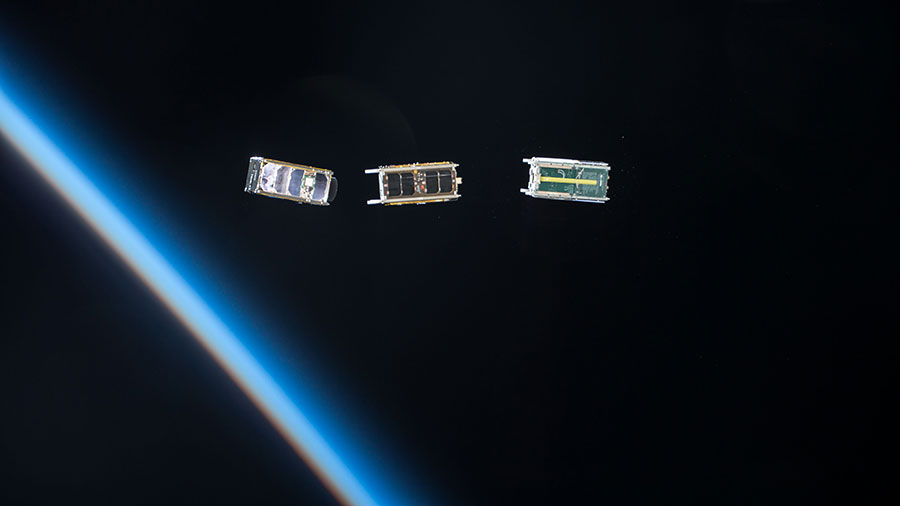Tiny Satellites Pose a Swarm of Opportunities — And Threats

Spaceflight favors big rockets and small technology — but when technology gets small enough, it may act very differently from traditional satellites and spacecraft.
And that tipping point may not be all that far away, with engineers having already flown tiny satellites that stretch just 1.3 inches (3.5 centimeters) across. With these tiny satellites come the potential opportunity to produce hordes of them, turning one large device into a host of smaller, cheaper ones.
"Right now these things are toys, but if folks decide to work on it, we can turn them into tools — it just takes effort," Pete Klupar, director of engineering for Breakthrough Starshot, the initiative to send a credit-card-size satellite to a neighboring solar system at incredibly fast speeds, told Space.com. "We have to do a lot of work to get them to the level of reliability and technology that they're actually valuable." But he said the Breakthrough Institute is excited to be pursuing these tiny satellites, and he expects more and more company in that work. [Explorer 1: America's First Satellite in Pictures]
The key draw is obvious: small price tags, and in turn, large quantities. The cost of fuel needed to get from Earth to space has always been a burden on designers, and these tiny satellites are small enough that — assuming you can shrink your technology enough to fit on board — they don't need as much fuel to reach orbit.
High quantities follow low prices, which means a shift in thinking from individual satellites to constellations of partners with redundancy built in: If a function is performed by a network of many satellites, any one device is no longer crucial. That's a very different way of thinking about space goals from individual spacecraft that are larger, more expensive and less replaceable.
And although these tiny satellites have so far remained close to Earth, Klupar expects they'll extend their domain. "If you want to go explore say a place like Jupiter or Saturn, having developed and used small, low-mass vehicles, whether they're individuals or in swarms, I think, can really help," Klupar said. "I would really love to be able to send these small tiny vehicles to either the outer planets or Venus, interplanetary space."
But at least near Earth, these tiny satellites come with plenty of threats as well as opportunities. Klupar said that the line between satellite and space junk is getting blurrier as satellites shrink. Space junk — the remains of former satellites — is already a serious problem, since anything in space does damage if it collides into a working satellite. And as humans have sent more and more satellites into space, junk has become more and more of a problem.
Get the Space.com Newsletter
Breaking space news, the latest updates on rocket launches, skywatching events and more!
That's why space junk and satellites alike are tracked by radar in order to alert owners to potential collisions and avert those threats. But right now, those systems can't see objects smaller than about 4 inches (10 centimeters) — and that means tiny satellites could orbit undetected and hit other satellites without warning.
"If we start to launch things that are smaller than the ability for the radars to pick them up, then we're going to have problems," Klupar said. "These little chips are getting down to that size where they may just barely be visible, and by their very nature since they act in swarms you're going to want to have lots of them up there." That means a lot of potential collisions — and while the tiny satellites would likely be working in swarms that could withstand some losses, the satellites they hit may not be so lucky.
And the particularly gnarly challenge of space junk is that it multiplies — a collision just splits objects into more smaller but still dangerous objects. If it gets out of hand, it could put entire orbital ranges out of action. To try to mitigate that, there's been talk of limiting tiny satellites to lower reaches of space, which aren't as crowded. That approach would also take advantage of the atmosphere's tendency to pull satellites out of orbit. Another possible mitigation strategy would attach antennae to the satellites to make them more visible.
Tiny satellites won't just rebalance the opportunities and threats of spaceflight — with their small price tags they will also reshape the players in space. "It wouldn't surprise me that a country like Bhutan or some random country decides, if they get it in their heads they want to do this, it's certainly achievable with very modest budgets." Klupar said. "You can't quite do a bake sale, but it's close."
And for Klupar, that could be a very promising development. "We need many people to think about the space problems and solve the space problems," Klupar said. "I think this is enabling for that."
Email Meghan Bartels at mbartels@space.com or follow her @meghanbartels. Follow us @Spacedotcom and Facebook. Original article on Space.com.
Join our Space Forums to keep talking space on the latest missions, night sky and more! And if you have a news tip, correction or comment, let us know at: community@space.com.

Meghan is a senior writer at Space.com and has more than five years' experience as a science journalist based in New York City. She joined Space.com in July 2018, with previous writing published in outlets including Newsweek and Audubon. Meghan earned an MA in science journalism from New York University and a BA in classics from Georgetown University, and in her free time she enjoys reading and visiting museums. Follow her on Twitter at @meghanbartels.









